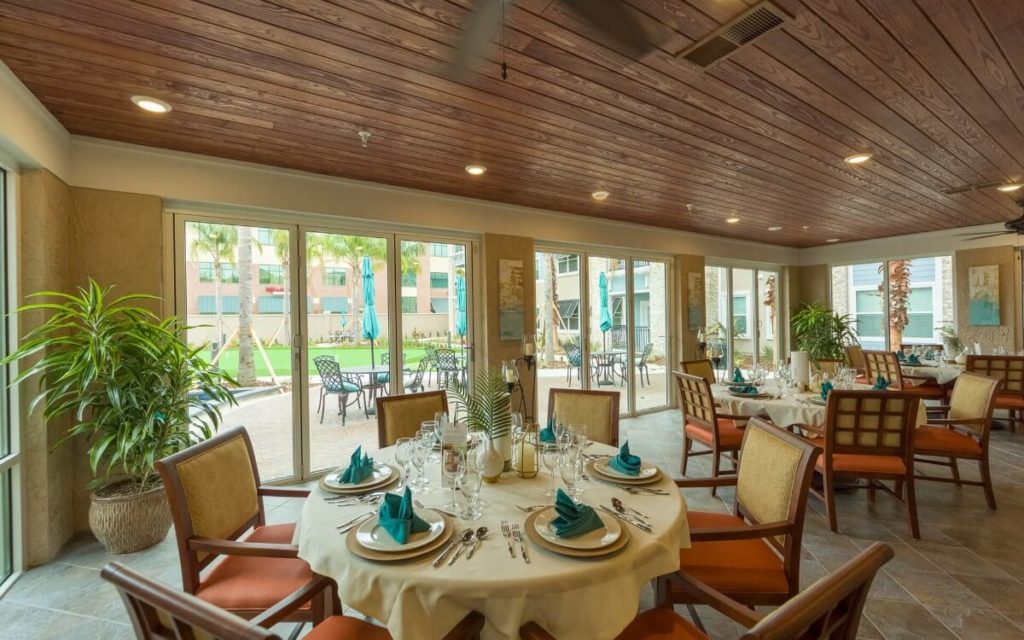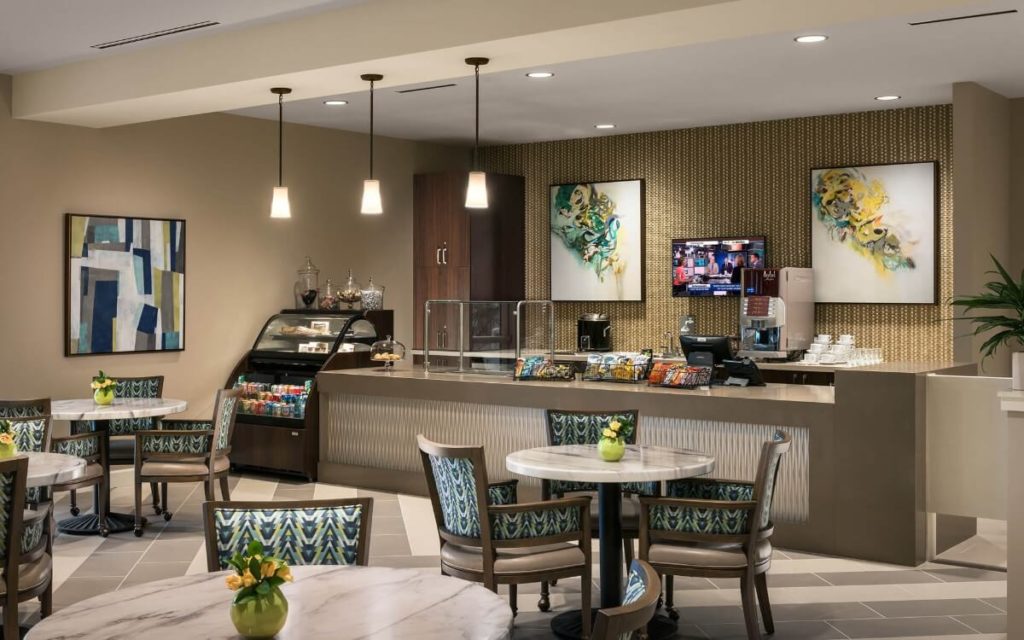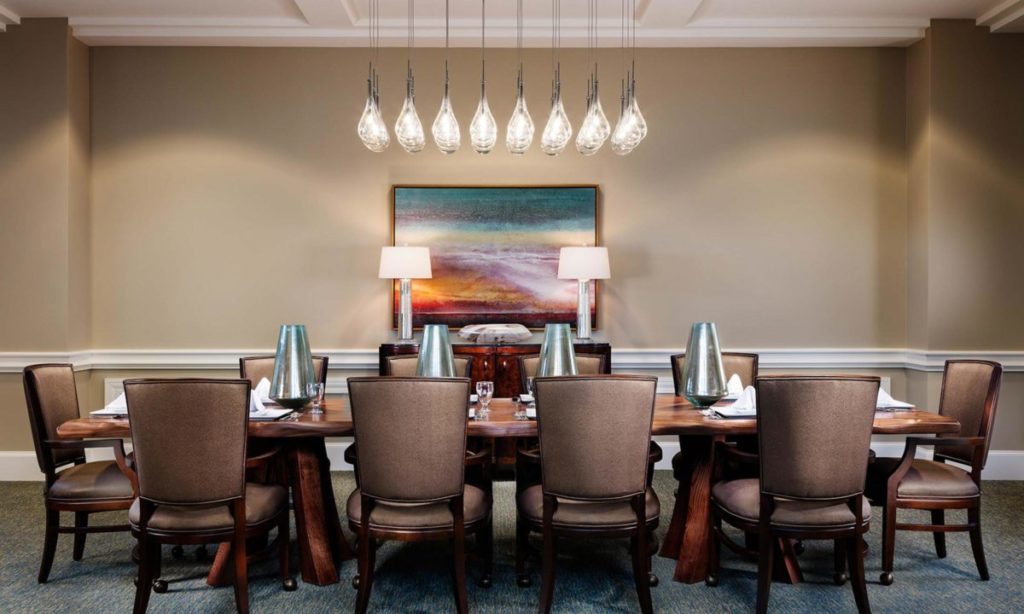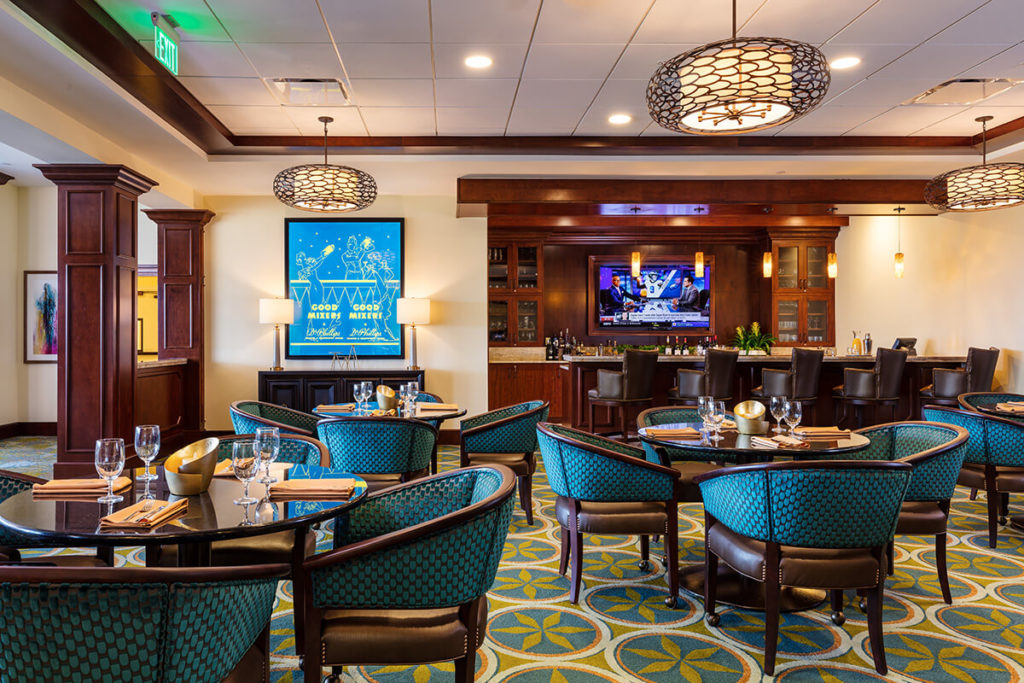Harbor Retirement Associates (HRA) doesn’t have “restaurant-style” dining venues, it has restaurants.
That’s the philosophy adopted by Chris Thompson, who became vice president of hospitality for the Vero Beach, Florida-based senior living operator about one year ago. In that role, Thompson is directly in charge of the company’s food and beverage initiatives, including its daily menus, the way its dining venues are designed and its front- and back-of-house operations.
For the past year, Thompson has focused on drawing top culinary talent, has redesigned the provider’s bistros with an “urban rustic” flair, and modeled HRA’s dining program in the image of a private country club, where it’s common for chefs to prepare a wide range of dishes for customers they see many times. HRA operates 34 communities across 10 states, with another 10 more communities on the way.
Senior Housing News caught up with Thompson to learn more about why he thinks that’s the way forward for senior living, and what the baby boomers might want as they start to move into communities en masse.
The following interview has been edited for length and clarity:
What have your priorities been this year?
Just recently, I had the opportunity to completely redesign our bistros top-to-bottom, where they’re really going to function more like standalone units, which I’m very excited about.
My goal when I came into this role was really to bring a contemporary approach to dining in senior living. I have a very short tenure in this industry, most of it out in what we would consider the conventional [food and beverage] industry.
When I came into senior living, I realized from a culinary standpoint that there was a lot of opportunity to bring us into contemporary dining models versus dietary dining or health care dining, where the industry was stuck in a stigma.
After being educated on what dining means in senior living and what it is we do, I realized there was a lot of opportunity there. What I’ve been pushing in the past year is making us more contemporary in our dining model, more contemporary in our menus.
We’re really putting a strong emphasis on modern plating principles and really expanding our menus in our multiple communities.
When you say contemporary, what does that mean as it relates to senior living?
It means following modern trends that are in the conventional restaurant industry.
So, that could be our approach to cooking techniques or plating concepts that are relevant these days. It’s what people are doing in typical private clubs or hotels or restaurants and really bringing that into senior living.
When I first came into the industry, I realized that senior living was pigeonholed into kind of a health care point of view versus mainstream dining.
I saw, at least from a culinary standpoint, that there was this one particular way of looking at senior living, and I wanted to counteract that and bring more modern plating techniques, current cooking techniques and more unique ingredient lists to the picture.
What’s hot in the mainstream dining world that you think translates well to senior living?
When we talk about plate composition, the industry has gotten to be a little more simplistic by nature. They’re really moving away from the heavy classic sauces. That’s primarily where I see a lot of movement. So, you are now working with more reductions, purees. It’s simple, lighter things.
There used to be more use of classic sauces, things with a lot of high fat content. For example, take your typical white sauce, a classic mother sauce. It’s got butter, flour, high amounts of cream and everything cheese in it.
Whereas nowadays, you may be working with just taking a vegetable or a fruit or a simple stock and reducing that down. You’re really removing a lot of the fat. Not only is it more simplistic by nature, it’s better for you. And, it’s also a contemporary approach to things.
So, that’s one good example of how you can take something out of the contemporary mainstream and integrate it into senior living. Not only does it make you modern, but it’s also better for you in the long run.
And from a culinary standpoint, too, the flavor really speaks. You’re allowing the composition of your dishes to rely more on the ingredients you’re using and the freshness of those ingredients than you are masking it with a lot of overpowering elements.
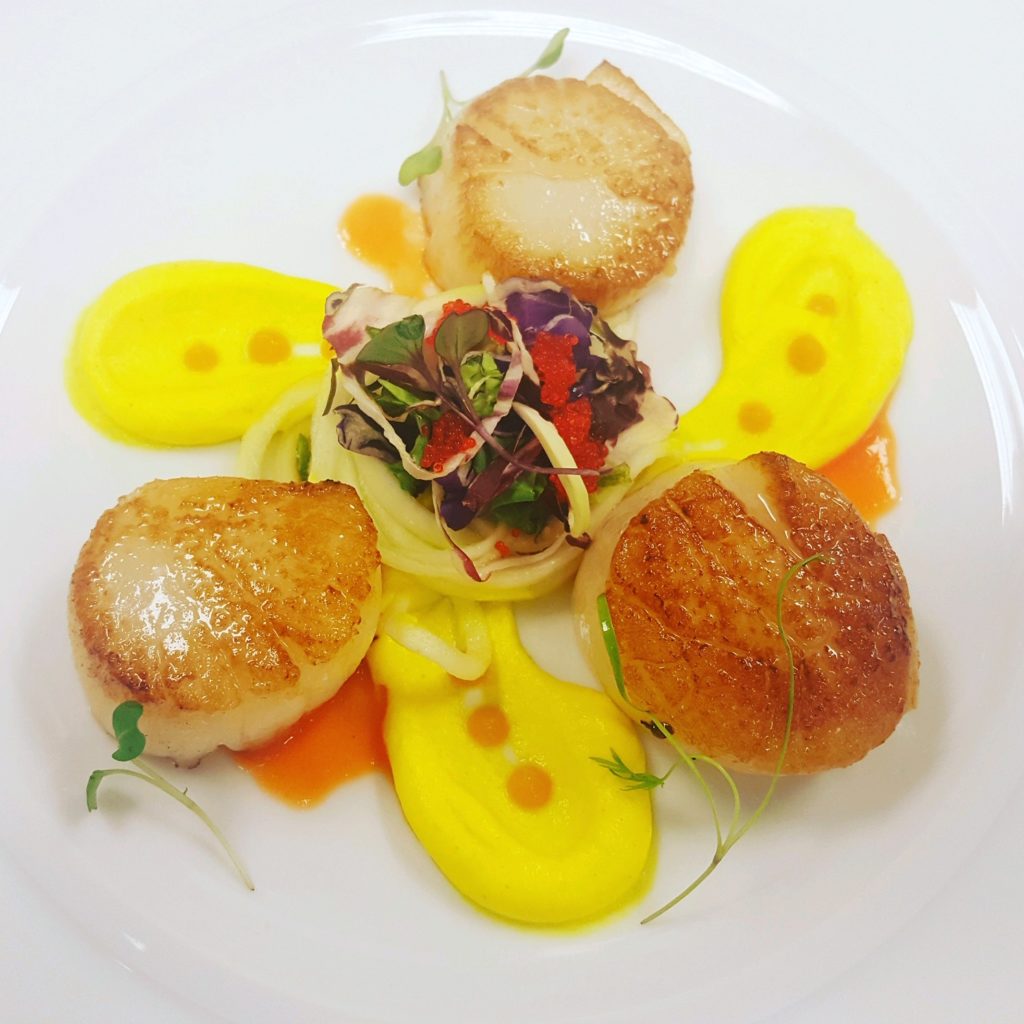 HRA
HRAAre residents usually embracing these more contemporary dining concepts, or do you need to adapt it for a meat-and-potatoes crowd?
What I preach to my chefs is to take a private country club mentality to things.
When I was an executive chef in the industry, I worked in a couple clubs. One of the things I realized was, you’re going to do a large range of cuisine in a club. You have a static membership, and in our industry you have, for the most part, have a static residency, where you’re seeing the same residents all the time.
You’re also going to have those that have specific preferences. So, I would do some pretty one-off things at the club for particular members that I wouldn’t normally have on my menu.
We can have a modern menu, where we do a prix fixe that’s more or less a contemporary approach to those classic meat and potatoes dishes. And that goes very well with our residents.
Where we’re really making that difference is in our a la carte dining. Our rule of thumb is, if it’s in-house, we’ll do it for you. If it’s this variety of things, then they’re not scared of it.
A lot of our chefs will also educate our residents on certain products or new cooking techniques so that, while they may be standoffish about it, they come to find out what it is exactly, and maybe the chef will put together a little tasting plate for them. And they end up rather surprised.
So, my approach toward dining is to have the full arc from ultra simplistic all the way over to fine dining, that leading edge of contemporary. What I don’t want to do is ever say we’re only going to go so far because we just have meat-and-potato residents.
By having that kind of balance between a meat-and-potato menu, so to speak, and the contemporary offerings, we are starting to see a huge uptick in families and guests coming in to our buildings to eat, which really warms me because what that’s telling me is that now their families are more prone to wanting to come to the community for dinner versus going to the community and feeling like they need to take Mom out to dinner.
What’s the difference between the prix fixe menu and the a la carte menu?
The prix fixe is the menu that is regulated by [a registered dietician]. That’s one we write, I write the menu decks, we send it off [to Crandall Corporate Dietitians]. They do work, like the regulatory documentation that comes along with it. So, that’s changed every single day.
Our a la carte menu is the other option, and it changes between breakfast, lunch and dinner. And that’s where you’re going to have all of those unique dishes. So, that would be more your traditional restaurant-style menu.
Because I hire really contemporary chefs out of private clubs or hotels, because their talent levels are so high, I’m able to give them the autonomy to write those a la carte menus and custom-design them specifically for a community.
What about specialized diets such as gluten-free, vegetarian or vegan?
It’s not often that we see it. Every now and again I’ll get an email from an executive director or a chef asking about gluten-free menus. I think we had one that was all plant-based.
Though we don’t specifically write menus for them, what we do feel is that we have have enough diversity inside of our menus that we are able to accommodate those. And again, getting back to that club chef mentality of, we’re able to provide them additional options or customize certain things for them.
We’ve seen some other consumer dining trends make their way into senior living, too, like fast casual or food halls. Seeing anything new or interesting like that?
I’m kind of fascinated with the urban element, which has been really hot over the last couple years. It’s kind of the opposite of refined food. The food is a little more rustic, it’s more true to nature. We’re not masking it with a lot of things.
There’s an uptick in paying more attention to the simple combination of ingredients that work really well. So, I like that rustic urban appeal, where fine dining, so to speak, is kind of not really at the forefront anymore.
You see it not only in the food, but in the way that restaurants are being designed and operated and service styles. I really like that edge. When we redesigned our whole bistro, it was really done around that urban bistro feel.
What I like about that specifically is it adds another element to the multiple dining venues we have in our buildings. I can do everything from rustic, refined super casual to fine dining. I think that’s a great area of opportunity.
Does HRA work with any local food brands, or do you have any thoughts about bringing in well-known chefs to partner with?
I’ll speak to the chefs first. This is one area that I recruit specifically for. One thing I’m very proud of is that we have very talented culinarians working in our buildings. I’m going to hotels, I’m going to resorts, I’m going to private clubs, and I’m getting people that don’t have a history in senior living.
The purpose of me doing that is, I want them to bring that modern contemporary approach to our menus and our dining because we do have such a high degree of autonomy at the community level when it comes to designing menus.
If I bring a chef in from a JW Marriott where there’s four or six restaurants inside of it, and they’ve been the driving force behind designing all those menus, it’s a perfect marriage. I say [to HRA’s chefs], I will build you a bookshelf but you determine how you stain it and what goes on it.
What that means is, I give them the framework and then turn them loose because I’m hiring the level of talent to do that. So, I don’t have a need to partner with chefs outside because that’s our model of recruiting.
We haven’t done any specific products being developed for us, per se. One relationship that I did start up last year was with a company called Produce Alliance. We really want to put a strong focus on that farm-to-fork, fresh, what’s in peak season in that particular area.
Even in our prix fixe menus, those vegetables are almost like the vegetable of the day, and so on. The other thing we do is, with us being so spread out, I make sure that our buildings are leveraging whatever local vendors they have to work with.
So, we’re really trying to get away from purchasing from a broadliner. So, if you do have a unique bakery in your area, I encourage them to use them for all your breads and rolls, for example. And if you have a good seafood distributor, go ahead and use it. It’s a culture of saying we want to work with local vendors so we can get the best product that we can.
Along those same lines, HRA recently linked up with a company that provides you with vertical herb gardens, right?
They started out as just these wall herb gardens. And this year, we partnered with a company called LiveWall. They’re not a vendor, but they are a manufacturer of vertical gardens. These will be mounted inside our dining rooms. We have one up now and we’re doing them with all of our new buildings moving forward, and then we’ll be retrofitting our previous luxury buildings that have already been developed.
What’s nice about this system is that you can actually incorporate a partnership with life enrichment, where you can have residents growing tomatoes, you can do dwarf peppers, you can do living lettuces. Really, anything you can grow in a conventional garden, you can grow on these boxes.
Each box has an insert, so you can keep a consistent cycle of swapping product in and out. So, a lot of times you’ll see a garden out back at community, where we can actually bring that physically inside.
In our exhibition kitchens, the chefs will use those on specialty dishes and for finishing dishes. It’s great, and we’re going to continue to expand on it. So far, it’s working really well.
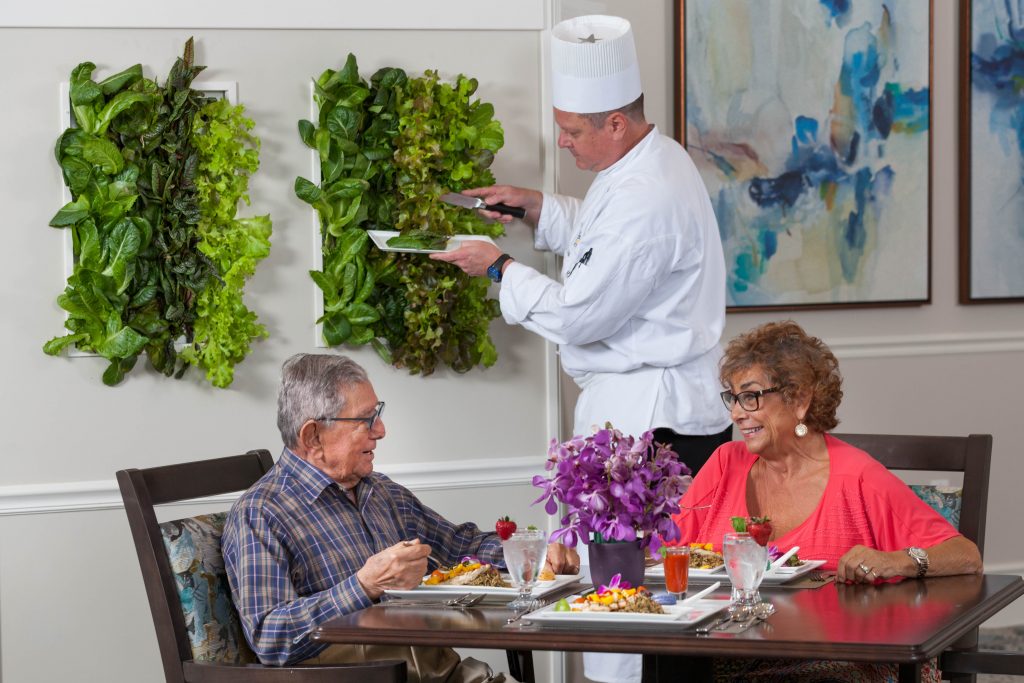 Harbor Retirement Associates
Harbor Retirement AssociatesIt seems like a lot of providers these days are playing up their hospitality or wellness programs. How does HRA stand apart in that crowded field?
I think it boils down to who you are recruiting to put in these and how much latitude you’re giving them to bring it to that level of what one might expect if you were out in a mainstream restaurant.
I’ve seen competitors say things like “restaurant style-dining” or “restaurant-style menus.” The way I look at it, and where I think we are different, is that we have restaurants. And that’s the way we run them, that’s the way our menus are written, that’s the way our service is conducted, that’s the way our dining rooms are set up. So, we treat them as restaurants, we run them as restaurants and we design them to be restaurants.
It’s not that we’re trying to say we can offer you something similar to a restaurant or it’s in the style of one. With us, it is that, and that’s where we really do stand out.

